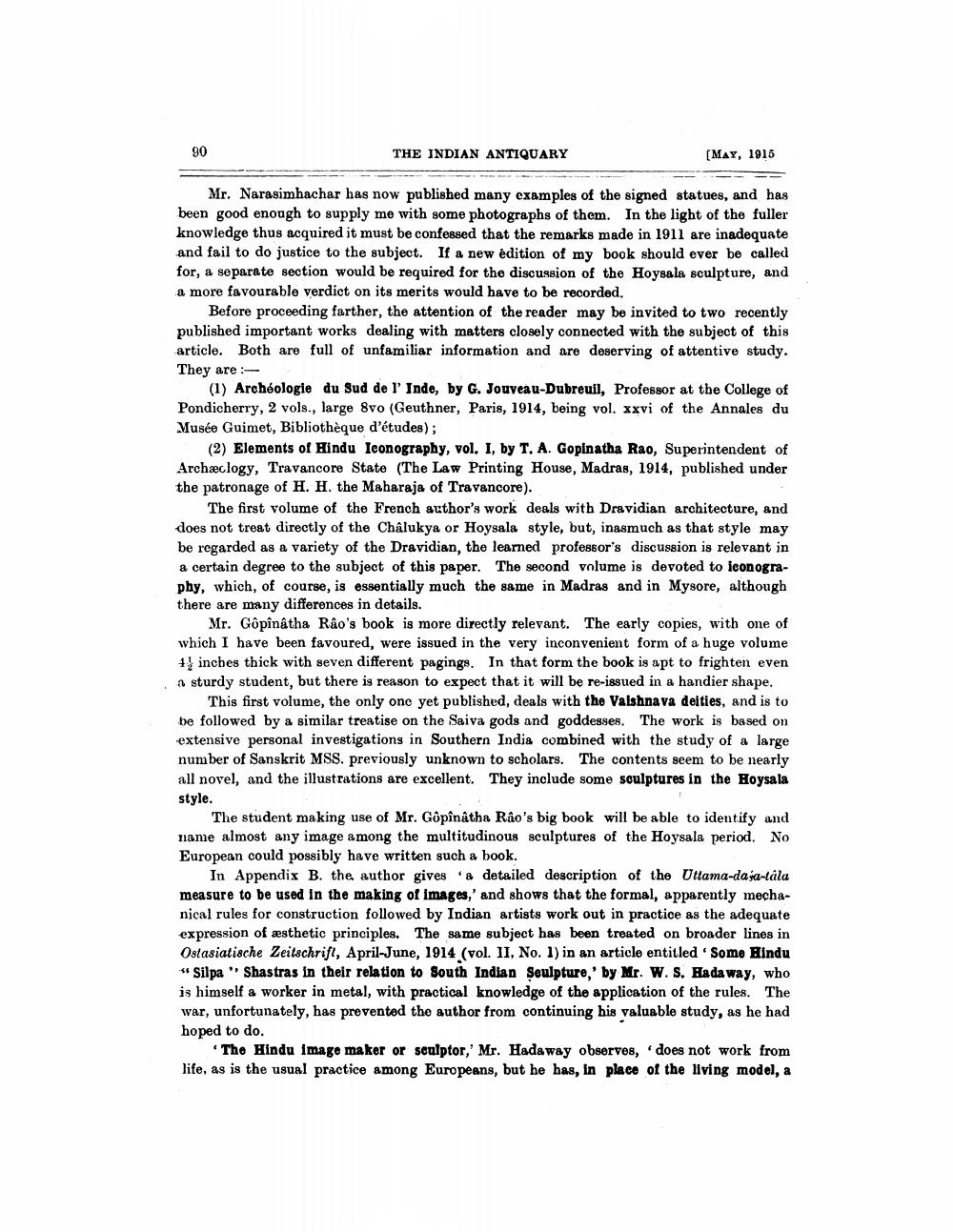________________
90
THE INDIAN ANTIQUARY
[MAY, 1915
Mr. Narasimhachar has now published many examples of the signed statues, and has been good enough to supply me with some photographs of them. In the light of the fuller knowledge thus acquired it must be confessed that the remarks made in 1911 are inadequate and fail to do justice to the subject. If a new edition of my book should ever be called for, a separate section would be required for the discussion of the Hoysala sculpture, and a more favourable verdict on its merits would have to be recorded
Before proceeding farther, the attention of the reader may be invited to two recently published important works dealing with matters closely connected with the subject of this article. Both are full of unfamiliar information and are deserving of attentive study. They are
(1) Archéologie du Sud de l'Inde, by G. Jouveau-Dubreuil, Professor at the College of Pondicherry, 2 vols., large 8vo (Geuthner, Paris, 1914, being vol. xxvi of the Annales du Musée Guimet, Bibliothèque d'études);
(2) Elements of Hindu Iconography, vol. I, by T. A. Gopinatha Rao, Superintendent of Archæclogy, Travancore State (The Law Printing House, Madras, 1914, published under the patronage of H. H. the Maharaja of Travancore).
The first volume of the French author's work deals with Dravidian architecture, and does not treat directly of the Châlukya or Hoysala style, but, inasmuch as that style may be regarded as a variety of the Dravidian, the learned professor's discussion is relevant in a certain degree to the subject of this paper. The second volume is devoted to iconography, which, of course, is essentially much the same in Madras and in Mysore, although there are many differences in details.
Mr. Gopinatha Rao's book is more directly relevant. The early copies, with one of which I have been favoured, were issued in the very inconvenient form of a huge volume 4 inches thick with seven different pagings. In that form the book is apt to frighten even a sturdy student, but there is reason to expect that it will be re-issued in a handier shape.
This first volume, the only one yet published, deals with the Valshnava deities, and is to be followed by a similar treatise on the Saiva gods and goddesses. The work is based on extensive personal investigations in Southern India combined with the study of a large number of Sanskrit MSS. previously unknown to scholars. The contents seem to be nearly all novel, and the illustrations are excellent. They include some soulptures in the Hoysala style.
The student making use of Mr. Gopinatha Rao's big book will be able to identify and name almost any image among the multitudinous sculptures of the Hoysala period. No European could possibly have written such a book.
In Appendix B. the author gives a detailed description of the Uttama-daya-tala measure to be used in the making of images,' and shows that the formal, apparently mechanical rules for construction followed by Indian artists work out in practice as the adequate expression of æsthetic principles. The same subject has been treated on broader lines in Ostasiatische Zeitschrift, April-June, 1914 (vol. II, No. 1) in an article entitled 'Some Hindu
Silpa "Shastras in their relation to South Indian Seulpture,' by Mr. W. S. Hadaway, who is himself a worker in metal, with practical knowledge of the application of the rules. The war, unfortunately, has prevented the author from continuing his valuable study, as he had hoped to do.
The Hindu Image maker or sculptor,' Mr. Hadaway observes, does not work from life, as is the usual practice among Europeans, but he has, in place of the living model, a




